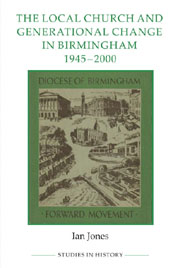Book contents
- Frontmatter
- Contents
- List of figures and tables
- Acknowledgements
- Abbreviations
- Map of Birmingham
- Introduction
- 1 Birmingham: the city and its churches
- 2 The spectre of ‘decline’
- 3 Church, youth and family from the 1940s to the 1960s
- 4 Life and worship in the local congregation
- 5 Church and neighbourhood: four congregational stories
- 6 Towards the margins: being Christian in a pluralist society
- Conclusion
- Appendix: Oral history
- Bibliography
- Index
4 - Life and worship in the local congregation
Published online by Cambridge University Press: 05 February 2013
- Frontmatter
- Contents
- List of figures and tables
- Acknowledgements
- Abbreviations
- Map of Birmingham
- Introduction
- 1 Birmingham: the city and its churches
- 2 The spectre of ‘decline’
- 3 Church, youth and family from the 1940s to the 1960s
- 4 Life and worship in the local congregation
- 5 Church and neighbourhood: four congregational stories
- 6 Towards the margins: being Christian in a pluralist society
- Conclusion
- Appendix: Oral history
- Bibliography
- Index
Summary
Whilst Christian identity, belief and practice have always meant more than merely churchgoing, and many late twentieth-century Britons considered themselves Christian without regularly attending church, it remained widely accepted that Christianity (as officially practised) involved collective religious observance. Since this congregational dimension has frequently been omitted from discussions of English Christianity in this period, this chapter seeks to put worship and congregational life back on the map, acknowledging both the wider cultural, theological and ecclesiastical influences on local churches and the way in which the congregation functioned as an important prism through which wider social and religious change was experienced and interpreted. It is impossible here to survey every aspect of postwar congregational life. Instead, three key trends are considered, each discernible in oral and documentary sources: first, a growing expectation that lay Christians would be active participants in local congregational worship and leadership; second, a tendency for worship and church life to become less ‘formal’ in style; and third, increasing (sometimes controversial) experimentation with new forms of popular culture within worship. Running through each of these, but particularly the latter, was a tendency for change to generate heated debate, some of which reflected changing needs and dispositions across the life course, and some of which reflected wider social generational differences in taste, behavioural norms and church experience.
First however, some contextualisation may be useful. The late twentieth century saw growing diversity within (and cross-fertilisation between) Christian denominations, contrasting with the more denominational direction of the late nineteenth and early twentieth centuries.
- Type
- Chapter
- Information
- Publisher: Boydell & BrewerPrint publication year: 2012

